When and How to Do Certain Postpartum Exercises
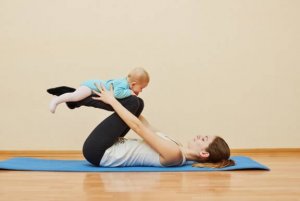
Postpartum exercise has different difficulty levels. Of course, each mother is different and therefore postpartum exercises should be incorporated based on each mother’s ability. Here are some tips on postpartum exercises and how you can go about beginning your routine after giving birth.
You might like: Is It OK to Exercise While I’m Pregnant?
During this time, it’s important to encourage the bond between mother and child. However, it’s true that after giving birth, women often feel like they are in a body that doesn’t belong to them.
After giving birth, the organs slowly begin to return to their original places. Although it’s true that women feel heavier and anxious about their appearance, the best advice is to have patience and slowly start to exercise. Additionally, new mothers should not be overly strict with their postpartum exercises.
Postpartum exercises for the first 40 days
In the first few days after giving birth, you can do exercises leaning more towards relaxation. These exercises will help aid your physical recovery in a gradual way. Some examples are:
1. Fake breathing
To do this, you need to expel all of the air in your lungs and, without inhaling again and with your mouth closed, suck in your abdomen. You can do this laying down, standing, or sitting on your calves.
This exercise will help with the relocation of your bladder and uterus. Additionally, it’s considered to be great preparation for working your abdominal muscles.
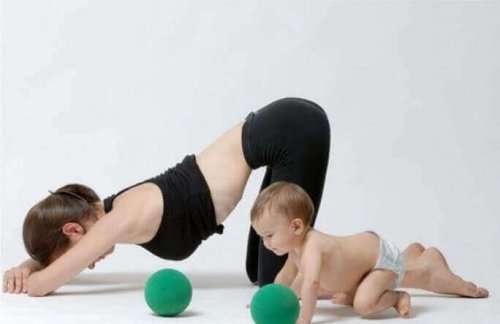
You might also like: The 4 Ways of Breathing and their Benefits
2. Ascending massages in the abdominal area
Self-massage from the pubis to the navel helps make up for the exertion of giving birth. This way, you will sooth some of the pressure that your organs suffered, by pressing and massaging upwards with the palms of your hands.
3. Elimination of gas
One type of pain produced in the abdomen is due to an accumulation of gasses. A great exercise for alleviating this is to lay down and slowly bring your knees to your chest while exhaling. As a result, you will eliminate gasses. You should always do this exercise without unnecessarily exerting yourself.
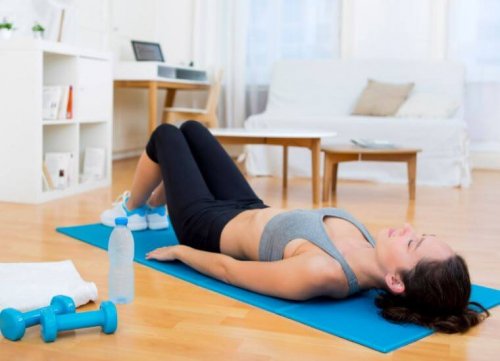
4. Internal massage
For this exercise, choose one of the positions mentioned for the fake breathing exercise. Then, suck your abdomen in and push it out. By doing this, you perform a kind of internal massage that will favor intestinal function.
Postpartum exercises for 40 days after giving birth
Restarting more intense physical activity is recommended after the 40 days after giving birth. It’s always better to start postpartum exercises in a controlled way and with a professional’s permission. Here are some great options.
1. Kegel exercises
The first exercise you need to do is aimed at strengthening the pelvic floor muscles, which were weakened during your pregnancy. This is will be a base for the rest of the exercises. In addition, it’s possible to start doing exercises before the 40 days following the birth. However, it all depends on the mother’s health and abilities.
Kegel exercises will not necessarily have a visible effect. The best way to do them is from a seated position, although you can also do them laying down.
Keeping your hips relaxed, move your pelvic floor muscles according to the following steps:
- contraction and lifting of the muscles
- hold the position
- return to start position
- relax
- repeat steps
In order to better explain how these exercises are done, it’s worth mentioning that these pelvic movements are the same as the ones you do when you urinate to stop the flow mid-urination.
It’s important to make sure you are in a comfortable place where you feel relaxed. In addition, you should also be in a comfortable position. When you start contracting your muscles, inhale deeply, as it will encourage this movement. Likewise, when you relax, exhale slowly.
With regard to frequency, you should start doing this exercise with three repetitions of 5 to 10 seconds, taking a rest of 5 seconds between each complete movement.
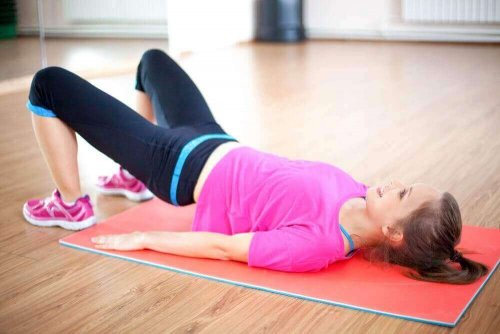
2. Exercises to retrain the perineum
The perineum must recover firmness in order for you to continue your exercises and move on to abdominal exercises. To work the perineum, lay face up and keep both legs slightly bent. When you exhale, contract and lift your pelvis. Then, hold this position for ten seconds. Afterward, repeat this series.
Another variation of this exercise is to keep your back on the floor. Additionally, you can bend one leg with your foot flat on the floor and cross the other leg over it.
Once you have this position ready, bring your hands to the knee that’s in suspension. Then, push against your knee while resisting the force with your other leg. Do a set of 7 then change legs.
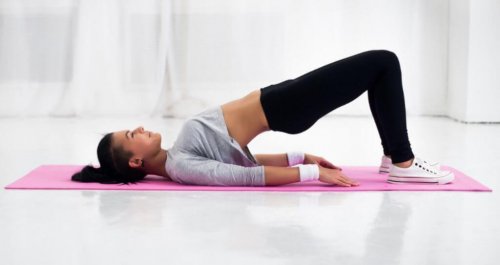
Postpartum exercises to incorporate last
Once your perineum area and your pelvic floor muscles are in optimum condition, you can start upping the intensity. As you advance in exercise speed or intensity, take it gradually and always consult with a doctor first.
Abdominal exercises will help you to recover firmness and tone your abdomen. Additionally, they should be incorporated slowly and gradually. At first, these movements should be gentle and you should do a few sets. As new mothers start to feel stronger, they can begin to incorporate more sets and increase the intensity of the exercises.
When you are performing these exercise routines, it’s important to stay relaxed. Furthermore, you should understand that results will not happen overnight. Now is the time to enjoy your new maternity and not worry so much about your figure.
Aerobic exercise and fitness center classes
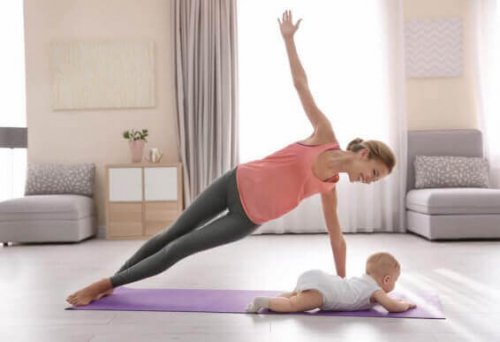
Forty days after you give birth, you can also begin doing aerobic exercise. First, we recommend that you take short walks to slowly improve your physical condition. As the days pass, you can increase the intensity and speed of these exercises.
It’s also possible to join group classes, especially those that allow women to share their experiences. In addition, new mothers can accompany each other during this process.
Finally, remember that some fitness centers actually have postpartum exercises and classes that include your baby! In these classes, you will do stretching, strength training, and even aerobics with your little one. In addition to working the body, you will also strengthen and deepen the bond between you and your child.
Postpartum exercise has different difficulty levels. Of course, each mother is different and therefore postpartum exercises should be incorporated based on each mother’s ability. Here are some tips on postpartum exercises and how you can go about beginning your routine after giving birth.
You might like: Is It OK to Exercise While I’m Pregnant?
During this time, it’s important to encourage the bond between mother and child. However, it’s true that after giving birth, women often feel like they are in a body that doesn’t belong to them.
After giving birth, the organs slowly begin to return to their original places. Although it’s true that women feel heavier and anxious about their appearance, the best advice is to have patience and slowly start to exercise. Additionally, new mothers should not be overly strict with their postpartum exercises.
Postpartum exercises for the first 40 days
In the first few days after giving birth, you can do exercises leaning more towards relaxation. These exercises will help aid your physical recovery in a gradual way. Some examples are:
1. Fake breathing
To do this, you need to expel all of the air in your lungs and, without inhaling again and with your mouth closed, suck in your abdomen. You can do this laying down, standing, or sitting on your calves.
This exercise will help with the relocation of your bladder and uterus. Additionally, it’s considered to be great preparation for working your abdominal muscles.

You might also like: The 4 Ways of Breathing and their Benefits
2. Ascending massages in the abdominal area
Self-massage from the pubis to the navel helps make up for the exertion of giving birth. This way, you will sooth some of the pressure that your organs suffered, by pressing and massaging upwards with the palms of your hands.
3. Elimination of gas
One type of pain produced in the abdomen is due to an accumulation of gasses. A great exercise for alleviating this is to lay down and slowly bring your knees to your chest while exhaling. As a result, you will eliminate gasses. You should always do this exercise without unnecessarily exerting yourself.

4. Internal massage
For this exercise, choose one of the positions mentioned for the fake breathing exercise. Then, suck your abdomen in and push it out. By doing this, you perform a kind of internal massage that will favor intestinal function.
Postpartum exercises for 40 days after giving birth
Restarting more intense physical activity is recommended after the 40 days after giving birth. It’s always better to start postpartum exercises in a controlled way and with a professional’s permission. Here are some great options.
1. Kegel exercises
The first exercise you need to do is aimed at strengthening the pelvic floor muscles, which were weakened during your pregnancy. This is will be a base for the rest of the exercises. In addition, it’s possible to start doing exercises before the 40 days following the birth. However, it all depends on the mother’s health and abilities.
Kegel exercises will not necessarily have a visible effect. The best way to do them is from a seated position, although you can also do them laying down.
Keeping your hips relaxed, move your pelvic floor muscles according to the following steps:
- contraction and lifting of the muscles
- hold the position
- return to start position
- relax
- repeat steps
In order to better explain how these exercises are done, it’s worth mentioning that these pelvic movements are the same as the ones you do when you urinate to stop the flow mid-urination.
It’s important to make sure you are in a comfortable place where you feel relaxed. In addition, you should also be in a comfortable position. When you start contracting your muscles, inhale deeply, as it will encourage this movement. Likewise, when you relax, exhale slowly.
With regard to frequency, you should start doing this exercise with three repetitions of 5 to 10 seconds, taking a rest of 5 seconds between each complete movement.

2. Exercises to retrain the perineum
The perineum must recover firmness in order for you to continue your exercises and move on to abdominal exercises. To work the perineum, lay face up and keep both legs slightly bent. When you exhale, contract and lift your pelvis. Then, hold this position for ten seconds. Afterward, repeat this series.
Another variation of this exercise is to keep your back on the floor. Additionally, you can bend one leg with your foot flat on the floor and cross the other leg over it.
Once you have this position ready, bring your hands to the knee that’s in suspension. Then, push against your knee while resisting the force with your other leg. Do a set of 7 then change legs.

Postpartum exercises to incorporate last
Once your perineum area and your pelvic floor muscles are in optimum condition, you can start upping the intensity. As you advance in exercise speed or intensity, take it gradually and always consult with a doctor first.
Abdominal exercises will help you to recover firmness and tone your abdomen. Additionally, they should be incorporated slowly and gradually. At first, these movements should be gentle and you should do a few sets. As new mothers start to feel stronger, they can begin to incorporate more sets and increase the intensity of the exercises.
When you are performing these exercise routines, it’s important to stay relaxed. Furthermore, you should understand that results will not happen overnight. Now is the time to enjoy your new maternity and not worry so much about your figure.
Aerobic exercise and fitness center classes

Forty days after you give birth, you can also begin doing aerobic exercise. First, we recommend that you take short walks to slowly improve your physical condition. As the days pass, you can increase the intensity and speed of these exercises.
It’s also possible to join group classes, especially those that allow women to share their experiences. In addition, new mothers can accompany each other during this process.
Finally, remember that some fitness centers actually have postpartum exercises and classes that include your baby! In these classes, you will do stretching, strength training, and even aerobics with your little one. In addition to working the body, you will also strengthen and deepen the bond between you and your child.
All cited sources were thoroughly reviewed by our team to ensure their quality, reliability, currency, and validity. The bibliography of this article was considered reliable and of academic or scientific accuracy.
- ACOG Committee on Obstetric Practice. (2002). Exercise During Pregnancy and the Postpartum Period. Obstet Gynecol, 99(2), 171–173. https://doi.org/10.1097/AOG.0b013e31823b17e3
- Blum, J. W., Beaudoin, C. M., & Caton-Lemos, L. (2004). Physical activity patterns and maternal well-being in postpartum women. Maternal and Child Health Journal, 8(3), 163–169. https://doi.org/10.1023/B:MACI.0000037649.24025.2c
- McCurdy, A. P., Boulé, N. G., Sivak, A., & Davenport, M. H. (2017, June 1). Effects of Exercise on Mild-to-Moderate Depressive Symptoms in the Postpartum Period: A Meta-analysis. Obstetrics and Gynecology. Lippincott Williams and Wilkins. https://doi.org/10.1097/AOG.0000000000002053
This text is provided for informational purposes only and does not replace consultation with a professional. If in doubt, consult your specialist.








